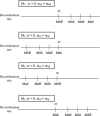The evolution of plastic recombination
- PMID: 16020791
- PMCID: PMC1456799
- DOI: 10.1534/genetics.105.041301
The evolution of plastic recombination
Abstract
Empirical data suggest that recombination rates may change in response to stress. To study the evolution of plastic recombination, we develop a modifier model using the same theoretical framework used to study conventional (nonplastic) modifiers, thus allowing direct comparison. We examine the evolution of plastic recombination in both haploid and diploid systems. In haploids, a plastic modifier spreads by forming associations with selectively favored alleles. Relative to nonplastic effects, selection on the plastic effects of a modifier is both much stronger and less sensitive to the specifics of the selection regime (e.g., epistasis). In contrast, the evolution of plastic recombination in diploids is much more restricted. Selection on plasticity requires the ability to detect DNA damage or cis-trans effects as may occur through maternal effects on fitness.
Figures

References
-
- Agrawal, A. F., 2002. Genetic loads under fitness-dependent mutation rates. J. Evol. Biol. 15: 1004–1010.
-
- Balyaev, D. K., and P. M. Borodin, 1982. The influence of stress on variation and its role in evolution. Biol. Zentbl. 100: 705–714.
-
- Barton, N. H., 1995. A general model for the evolution of recombination. Genet. Res. 65: 123–144. - PubMed
-
- Bürger, R., 2000. The Mathematical Theory of Selection, Recombination, and Mutation. John Wiley, New York.
Publication types
MeSH terms
Grants and funding
LinkOut - more resources
Full Text Sources

